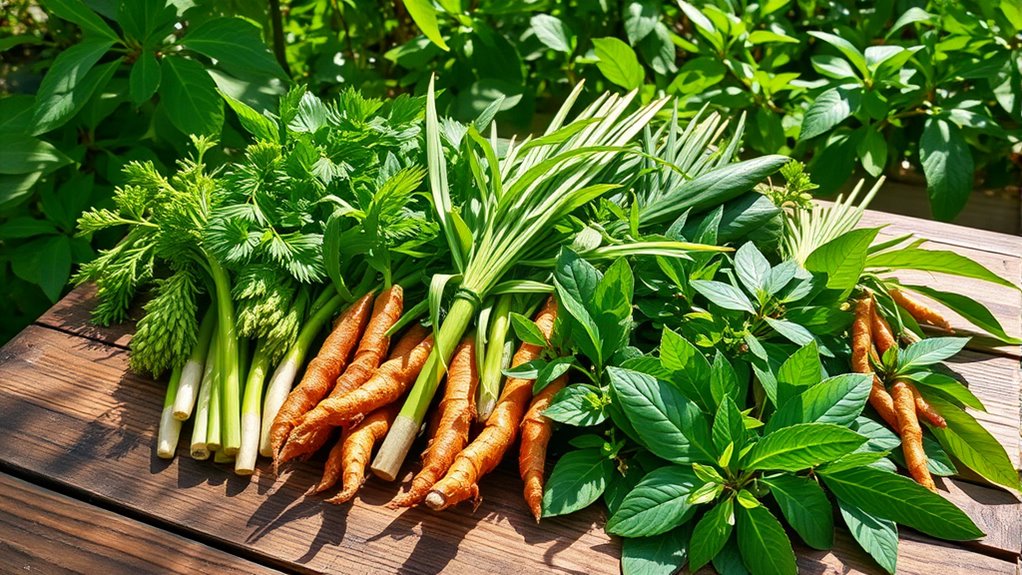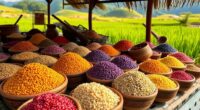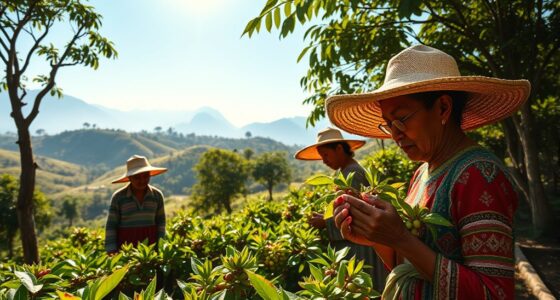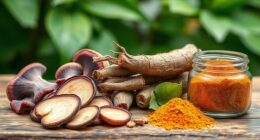Discover the rich diversity of lesser-known Indonesian herbs that add vibrant flavors and healing properties to regional cuisine. Herbs like temu kunci, binahong, and laksa leaves are traditionally used for medicinal purposes and culinary enhancements. These unique ingredients connect you to Indonesia’s cultural heritage and sustainable practices. Exploring these herbs reveals how they can elevate your dishes and wellness routines. Keep exploring to uncover more about these fascinating regional flavors and their authentic uses.
Key Takeaways
- Lesser-known Indonesian herbs like temu kunci, binahong, and laksa leaves showcase diverse regional flavors and traditional medicinal uses.
- These herbs add unique, vibrant tastes and health benefits to local dishes, emphasizing Indonesia’s rich culinary heritage.
- Incorporating indigenous herbs supports sustainable practices and promotes preservation of regional botanical diversity.
- Regional herbs often serve dual roles as natural remedies and flavor enhancers in traditional Indonesian cuisine.
- Spotlighting these herbs encourages culinary exploration and cultural appreciation of Indonesia’s lesser-known botanical wealth.

Indonesia is home to a wealth of herbs that often fly under the radar but offer incredible health benefits and unique flavors. Among these, lesser-known Indonesian herbs provide a fascinating glimpse into the country’s rich botanical diversity. You might not have heard of all of them, but exploring their traditional medicinal uses and culinary applications can open new doors to your health and cooking adventures.
Take, for example, temu kunci, a small, aromatic herb used widely in traditional medicine to treat digestive issues, fever, and colds. Its leaves and roots are often brewed into teas or poultices, harnessing their natural healing properties. When it comes to culinary applications, temu kunci adds a bright, citrusy flavor to dishes like sambal or grilled meats, bringing a crisp, tangy punch that elevates simple recipes into something special. Its versatility makes it a staple in many Indonesian kitchens, even if it remains relatively unknown outside the region.
Another intriguing herb is binahong, which is prized both for its healing qualities and its culinary uses. Traditionally, people use binahong leaves to heal wounds, reduce inflammation, and support respiratory health. You’ll often find the leaves boiled into herbal teas or mashed into poultices. In the kitchen, however, binahong leaves are sometimes used in salads or as a cooked green, imparting a mild, slightly bitter flavor that complements rice and vegetable dishes. Its dual role as medicine and food hints at a deep cultural connection to natural healing and sustainable eating practices.
Similarly, the herb called laksa leaves, or Vietnam coriander, is a lesser-known gem in Indonesia’s herbal landscape. Traditionally, it’s used to soothe digestive issues and boost immunity, with leaves often steeped into teas or added to topical remedies. In culinary terms, laksa leaves are prized for their aromatic, lemony flavor. They’re commonly added to soups, salads, and noodle dishes to provide a revitalizing burst of flavor. Their unique scent and taste can transform a simple dish into something vibrant and fragrant, making them a favorite among those who value bold, regional flavors.
Exploring these lesser-known herbs reveals that Indonesia’s botanical wealth isn’t just about flavor but also about health. Their traditional medicinal uses and culinary applications demonstrate how indigenous plants can serve dual purposes, enriching your health while elevating your cooking. Incorporating these herbs into your routine can also enhance your understanding of traditional practices and promote sustainable use of natural resources. Once you start incorporating these herbs into your routine, you’ll see how they connect you to Indonesia’s rich culinary and medicinal traditions, offering a taste of regional authenticity in every bite and sip.
Frequently Asked Questions
How Do These Herbs Influence Local Indonesian Cuisines?
You’ll find that these herbs greatly influence local Indonesian cuisines by adding unique herb flavor profiles that define each dish. Their cultural significance runs deep, often symbolizing tradition and regional identity. When you cook with them, you preserve heritage and bring authentic tastes to life. These herbs not only enhance flavors but also connect you to Indonesia’s rich history, making every meal a vibrant celebration of local culture.
Are These Herbs Available Outside Indonesia?
You might think these herbs are as common as your everyday spices, but ironically, exporting herbs from Indonesia isn’t that simple. Market availability outside the country is limited, making it tough to find these lesser-known herbs in local stores. While some specialty markets and Asian grocery stores carry them, most people have to settle for dried or powdered versions, far from the fresh, vibrant flavors they originally offer.
What Are Traditional Medicinal Uses of These Herbs?
You’re curious about traditional medicinal uses of these herbs. In herbal healing, locals often use them to treat common ailments like colds, fevers, and digestive issues. They’re woven into traditional remedies for inflammation, wounds, and even stress relief. While some herbs are available outside Indonesia, their use in herbal healing remains rooted in age-old practices, highlighting their cultural importance in maintaining health through natural, traditional remedies.
How Are These Herbs Cultivated and Harvested?
You’ll want to focus on proper herb cultivation by selecting nutrient-rich soil and providing adequate sunlight. Regular watering and organic fertilization encourage healthy growth. When it’s time to harvest, use precise harvest techniques, such as trimming at the right time and avoiding overharvesting, to guarantee plant sustainability. Careful handling during harvest helps preserve the herbs’ flavors and medicinal properties, making your herbal supply both potent and sustainable.
Can These Herbs Be Incorporated Into Modern Fusion Dishes?
Imagine these herbs as secret keys revealing new flavor fusion possibilities. You can easily incorporate them into modern dishes through clever herb pairing, blending their unique profiles with familiar ingredients. Their vibrant, regional essence adds depth and intrigue, turning everyday meals into culinary adventures. Embrace these lesser-known Indonesian herbs, and watch them transform your fusion creations into memorable, culturally rich experiences that captivate your palate and elevate your cooking artistry.
Conclusion
Discovering lesser-known Indonesian herbs opens a world of unique flavors you won’t find elsewhere. Did you know that over 40% of Indonesia’s herbs are still underutilized, holding untapped culinary and medicinal potential? By exploring these hyper-regional ingredients, you not only enrich your palate but also support local communities and preserve cultural heritage. So, next time you cook, consider experimenting with these hidden gems—you might just uncover your new favorite flavor while contributing to a vibrant tradition.








